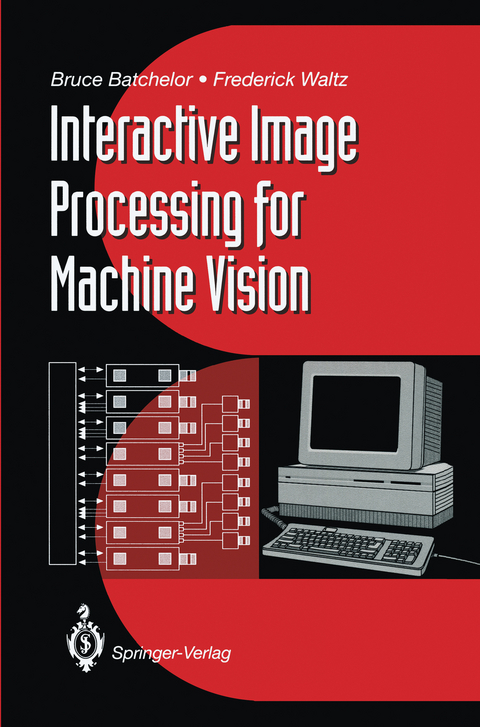
Interactive Image Processing for Machine Vision
Springer Berlin (Verlag)
978-3-540-19814-7 (ISBN)
1 Setting the Scene.- 1.1 Human and Animal Vision.- 1.2 Machine Vision.- 1.2.1 Machine Vision Functions.- 1.3 Applications of Image Processing.- 1.3.1 Health Services.- 1.3.2 Security and Forensic Science.- 1.3.3 Military.- 1.3.4 Commercial.- 1.3.5 Industrial.- 1.3.6 Earth Resources.- 1.3.7 Entertainment and Leisure.- 1.3.8 Domestic.- 1.3.9 Broadcast Television.- 1.3.10 Agriculture and Food.- 1.3.11 Communications.- 1.3.12 Education and Training.- 1.3.13 Service Industry, Transport.- 1.3.14 Research.- 1.4 Problems of System Design.- 1.4.1 Simplifying the Task.- 1.4.2 A Warning.- 1.4.3 Non-Industrial Image Processing.- 1.5 Interactive Image Processing (IIP).- 1.6 Practical Uses of Interactive Image Processing.- 1.7 Purpose and Outline of This Book.- 2 Principles of Digital Image Processing.- 2.1 Digital Representations of Images.- 2.1.1 Monochrome (Grey-Scale) Images.- 2.1.2 Binary Images.- 2.1.3 Color and Multispectral Images.- 2.1.4 Stereoscopic Image Pairs.- 2.1.5 Moving Images.- 2.2 Processing Functions.- 2.2.1 Notation.- 2.2.2 Monadic Point-by-Point Operators.- 2.2.3 Dyadic Point-by-Point Operators.- 2.2.4 Local Operators.- 2.2.4.1 Linear Local Operators.- 2.2.4.2 Non-Linear Local Operators.- 2.2.4.3 Using Direction Codes.- 2.2.5 n-tuple Operators.- 2.2.6 Edge effects.- 2.2.7 Global Image Transforms.- 2.2.8 Geometric Transforms.- 2.3 Binary Images.- 2.3.1 Measurements on Binary Images.- 2.4. Commentary.- 3 Syntax of IIPL.- 3.1 Introduction.- 3.2 Basic Commands.- 3.3 Command Sequences.- 3.4 Registers.- 3.5 Looping, Jumps, and Conditional Jumps.- 3.6 Macros.- 3.6.1 Macro Names.- 3.6.2 Macros Take Precedence Over Basic Commands.- 3.6.3 Programming Style.- 3.6.4 Macro Arguments, Numeric Values.- 3.6.5 Macros Incorporating Other Macros.- 3.6.6 Macro Arguments Generalized.- 3.6.7 Recursion.- 3.6.8 Library and User-Defined Macros.- 3.6.9 Further Remarks Relating to Macros.- 3.7 Histogram Buffer.- 3.8 Character Strings.- 3.9 Miscellaneous Control Features.- 3.10 Calling User-Defined Functions.- 3.11 Discussion and Summary.- 3.11.1 Choice of Mnemonic Form.- 3.11.2 Repertoire of Basic Commands.- 3.11.3 History, Variations on a Theme.- 3.11.4 Résumé.- 3.12 Addendum.- 3.12.1 Incorporating Basic-Like Features into IIPL.- 3.13 Prolog+, Merging Prolog with IIPL.- 4 Practical Considerations.- 4.1 Workstation Layout.- 4.1.2 Ergonomic Factors.- 4.1.3 System Response Times.- 4.1.4 Recording Results.- 4.2 Extending the Scope of IIPL.- 4.2.1 Controlling Dedicated Image Processing Hardware.- 4.3 Adding a Processor to Control the IIP.- 4.4 Using a Journal to Generate Macros.- 4.5 Can We Use AI Techniques to Guide the IIPL User?.- 4.6 Generating Software for Target Systems.- 4.7 Hardware-Based Versions of IIPL.- 4.7.1 IIPL/H System 1: A Basic System.- 4.7.2 IIPL/H System: Added Capabilities.- 4.7.3 IIPL/H System 3: A System for Desktop Computers.- 4.7.4 Status of IIPL/H Implementations.- 4.8 Menu Selection of Commands.- 4.9 Using a Mouse in IIPL.- 4.10 Pseudo-Color.- 4.11 Conclusions.- 5 Applications Case Studies.- 5.1 Crack Detection in Metal Components.- 5.2 Robotic Manipulation of Objects.- 5.3 Form Measurement of Glassware (Bottle).- 5.4 Examination of Aerosol Sprays.- 5.5 Examination of Paint Work.- 5.6 Inspecting Factory-Made Cakes.- 5.7 Inspection of the Cap of an Electric Light Bulb.- 5.8 Measurement of Coiling of a Helical Lamp Filament.- 5.9 Detecting Glass Flakes.- 5.10 Locating the Ends of Floppy Serpentine Objects.- 5.11 Verifying the Existence of a Chamfer.- 5.12 Inspecting Non-Populated Printed Circuit Boards.- 5.13 Checking the Roundness of Fruit.- 5.14 Reading Punched Lettering on a Metal Surface.- 5.15 Identifying a Playing Card.- 5.16 Determining the Orientation and Pitch of a Grid.- 5.17 Existential Inspection of Internal Threads.- 5.18 Processing Laser Scanner Data of Metal Surfaces.- 5.19 Checking LCD Displays.- 5.20 Aligning Teeth on a Gear.- 5.21 Determining Hardness of aMetal Surface.- 5.22 Counting Diskettes in a Cardboard Box.- 5.23 Deciding on the Toss of a Coin.- 5.24 Counting the Teeth on a Rubber Belt.- 5.25 Calibrating a Spirit Level.- 6 Integrating IIPLwith Prolog.- 6.1 Introduction.- 6.1.1 Predicates.- 6.1.2 Facts.- 6.1.3 Queries.- 6.1.4 Rules.- 6.1.5 Back-Tracking.- 6.1.6 Recursion.- 6.1.7 Lists.- 6.1.8 Built-in Predicates.- 6.2 Earlier Attempts to Combine Prolog and Image Processing.- 6.3 Specification of Prolog+.- 6.3.1 Syntax.- 6.3.2 Accommodating IIPL Commands with No Arguments.- 6.3.3 Accommodating IIPL Commands with Arguments.- 6.3.4 Passing Parameters Follows Normal Conventions.- 6.3.5 Interactive Operation of Prolog+.- 6.3.6 Prolog+ Rules Replace IIPL Macros.- 6.3.7 Program Control.- 6.3.8 Predicates for Controlling Other Devices.- 6.4 Some Applications.- 6.5 Implementation of Prolog+.- 6.6 Discussion.- 7 In Conclusion.- 7.1 A Seeing Is Worth 10,000 Tellings.- 7.2 Alternative Modes of Interactive Image Processing.- 7.2 Future Prospects.- References.- Table of IIPL Basic Commands.
| Erscheint lt. Verlag | 31.3.1993 |
|---|---|
| Zusatzinfo | XVII, 385 p. |
| Verlagsort | London |
| Sprache | englisch |
| Maße | 155 x 235 mm |
| Gewicht | 728 g |
| Themenwelt | Technik ► Elektrotechnik / Energietechnik |
| Technik ► Maschinenbau | |
| Schlagworte | Automated visual inspection • Computer Science • Digitale Bildverarbeitung • Electrical Engineering • Engineering Economics • Image Processing • Interactive design • Machine vision • Physics • robot • Robot vision • Science • Software |
| ISBN-10 | 3-540-19814-8 / 3540198148 |
| ISBN-13 | 978-3-540-19814-7 / 9783540198147 |
| Zustand | Neuware |
| Haben Sie eine Frage zum Produkt? |
aus dem Bereich


